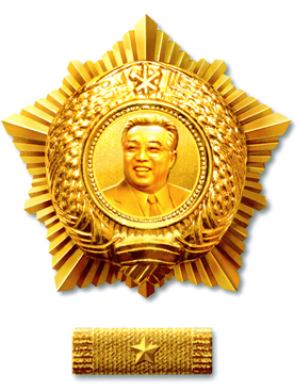Type Order Next (higher) Hero of Labour | Total awarded More than 600 Equivalent Order of Kim Jong-il | |
 | ||
Awarded for Outstanding services to the republic of the Korean nation and communism Established 20 March 1972 (1972-03-20) | ||
The Order of Kim Il-sung is the highest order of North Korea, along with the Order of Kim Jong-il, and only second to one honorary title, the Hero of Labour.
Contents
The order was instituted in 1972 during a reform of the North Korean honors system. Its history is not fully known, but the order was initially round, being changed to a five-pointed star design later, and the picture of Kim Il-sung updated in 2012.
Recipients can be individuals or organizations, who have contributed to the cause of communism. It is traditionally awarded on 15 April, the Day of the Sun, the birthday of Kim Il-sung. Relatively few are awarded, totaling at least 600, to highlight the high symbolic status of the order. Recipients include Kim Jong-il, who received it four times. He was supposed to be the recipient of the first award in 1972, but according to North Korean sources, he initially refused.
History
The North Korean system of orders and medals saw periods of expansion and stagnation through the 1950s and 1960s, but in the early 1970s, major additions were made. Of these, the most important one was the addition of the Order of Kim Il-sung to the list of titles. The order was instituted on 20 March 1972 on the occasion of the 60th birthday of Kim Il-sung. At about the same time, North Korea also started awarding watches with Kim Il-sung's autograph on them. According to North Korean sources, Kim Jong-il was to be the first recipient of the order, but he declined it and received the honor only in 1979.
In 2012, all orders bearing the picture of Kim Il-sung, including the Order of Kim Il-sung, were redesigned with a newer picture of Kim. At some point before that, the order had become a five-pointed star, being formerly round. It is possible that all old versions were recalled and changed to the new one.
Eligibility
The order is traditionally awarded annually on 15 April, the birthday of Kim Il-sung. It is awarded for "outstanding services to the Republic of the Korean nation and communism".
Out of all North Korean orders, it is awarded the most sparingly, reflecting its high symbolic status. At least 600 have been awarded.
Precedence
The order is the highest of the order of North Korea, along with the Order of Kim Jong-il, although out of titles the Hero of Labour is considered higher. The Order of the National Flag is one rank lower.
There are related prices called the Kim Il-sung Prize, as well as prizes for youth and children.
